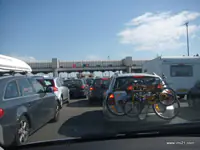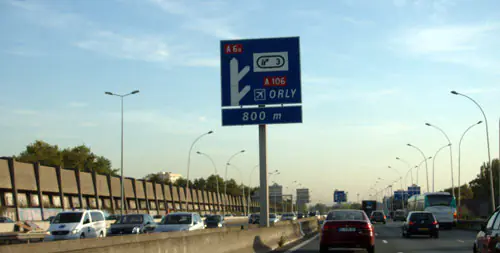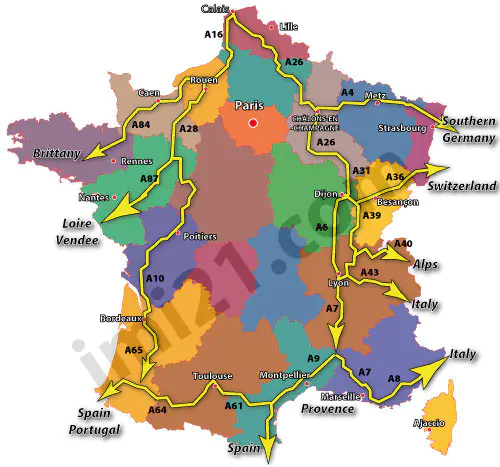The Autoroutes in France

Remember in July and August, traffic can be very dense!
Autoroute are the same as a freeway or motorway. In France, many of the main Autoroute have toll fees to pay ("Péage"). The autoroute use a numbering system with the letter A at the beginning such as the famous A6 ("l'autoroute du soleil").
The different autoroutes are owned by various companies, so you will generally pay more than one toll to get across France. The price depends on your vehicle and the distance driven. You can pay the fee with cash, credit card or rent a wireless box. Traffic can be very dense at certain times of the year, so prepare your dates and avoid travelling on the same days as the French holiday calendar.
There is also a very helpful radio station which broadcasts information 24/7 on FM 107.7 on all motorways in France, providing up to date details of traffic conditions, alerts and deviations.
The speed limit on all French motorways is 130-kmh on dry roads, 110 kmh on wet roads. Normally when there is "fog" the limit is 50-kmh, but nobody seems to respect this. On a national road the limit is 90-kmh whilst in urban areas there is a 50-kmh restriction.
During the last few years there has been a huge amount of automatic radars installed all over France on the autoroute and also minor roads. This is an attempt to reduce the number of accidents and deaths on the roads. The project is successful as there has been a dramatic reduction in the number of killed.

Priority to the right
Confused ? Curious ? Driving in France ?
Learn about giving way to the right in France.
You'll find an article in the forum about the "priorité à droite"
The Autoroutes
The official web site grouping all the autoroutes together, there is a map, estimation of toll costs, web cams, traffic situation.
Just as a note, if you breakdown on the Autoroute, you will have to pay to be towed off and it you may be fined for running out of petrol.
- What's the traffic like, check to see traffic flows, green, orange, red and BLACK zones on the dates you want to travel.
- Societe des Autoroutes Paris Normandie
- SANEF, Northern Autorutes
- Societe des Autoroutes Paris Rhone Rhine
- ASF, Autoroutes Sud France
- Cofiroute, Western France
- Escota, South East France
- Area, Rhone Alps
- ATMB, Autoroute tunnel Mont Blanc
The prices and toll fees on the autoroutes
There is not much in listing the costs of driving on the paying autoroutes in France as there are so many possibilities. What you should remember is that the final price will depend on the type of vehicles and if there is a trailer or caravan plus the distance you have driven on the paying section. The type of vehicles are divided into 5 different groups.
- Class 1 : Height less than 2 metres and the total weight is less than 3.5 tonnes. Most light vehicles such as cars, 4x4s, mono-spaces with or without a trailer that is less than 2 metres high
- Class 2 : Height between 2 and 3 metres and the total weight is less than 3.5 tonnes. A class 1 vehicle towing a trailer/caravan that is between 2 and 3 metres high; most camping cars or utility vans; pickup vans with habitable space
- Class 3 : Height is above 3 metres, 2 axles or the total weight is over 3.5 tonnes. HGV, buses and large camping vans
- Class 4 : Height is above 3 metres, 3 or more axles, the total weight is over 3.5 tonnes. Also a Class 2 with a trailer/caravan which has a height of more than 3 meters
- Class 5 : Motor-bikes with or without a side car, 3 wheel bikes
You can use most bankers cards or cash at the toll gate.
Tips to avoid driving through Paris

Here are some suggested itineraries and routes if you are driving into France from Calais (or another place in the north) and want to avoid going near to Paris.
To Brittany : take the A16 towards Rouen then the A84
To the south-west of France : take the A16, the A28 then the A87
To Germany : The A6 then the A4 to Metz, head towards Strasbourg
To the Alps : The A26, direction Dijon, then the A39 and A4
To Italy : The A26, direction Dijon, then the A39 , the A43 and then the tunnel at Frejus
To the Provence and the south : The A26, direction Dijon, the A31, A6, A7 and then the sunshine.
Important tip : Avoid travelling southwards on Friday nights and Saturday mornings; but also northwards on Sundays during the French holiday periods. Places to avoid at peak travel times are Lyon, but also the junction with the A9 and A7 south of Avignon.
Roads
Other road categories are National roads (N1), Departemental
(D15) and then Communal (C15). The highway-code rule of Priority
to the right
still exists on the smaller roads and in urban areas,
so beware and if you are not sure Give way to traffic coming from
the right.
Planning your route
Mappy provides a complete itineraries for most towns in France with toll costs, distances and journey times.
Michelin, the famous hotel, restaurant guide also provides excellent maps and route plans for any journey across France.
How the radar work
The automatic radar has been installed along many roads and autoroutes. They are set to take a photograph of the number plate on the offending vehicle, if it is 5-kmh above the limit for maximum speed allowed in the zone. The radar will send the photograph to a central office, the address of the owner of the vehicle matching the number plate will be found, the owner will have an automatic fine and a reduction in points from his driving license.
The police also use mobile radars, on-board unmarked cars or set along side the road to trap offenders and can fine or impound foreign registered vehicles on the spot.